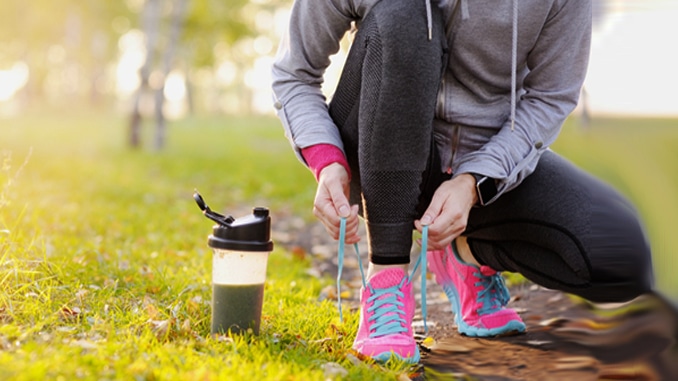
“Detoxify” is a popular word in various health circles today. Yoga, aerobic exercise, fasting, juice cleanses and even sitting in a sauna are all methods that are advertised as helping to rid your body of potentially dangerous toxins that could affect your health.
The idea is that because we’re exposed to many more environmental chemicals in today’s world than ever before through the food we eat, the air we breathe and the products we use, we need to help the body get rid of them.
Usually, it’s the kidneys and liver that are responsible for cleaning out the garbage, so to speak, but there is some debate now as to whether they are drowning under the current chemical load and could use some assistance.
When we looked into this issue, we found only one thing that so far, has shown some evidence in scientific studies to help you get rid of some of the toxins you may be absorbing — good old-fashioned exercise.
Today’s Adults Are Full of Chemicals
As a result of recent analyses of human exposure to environmental chemicals made by the Centers for Disease Control and Prevention (CDC), we know that adults in the United States show widespread exposure to: (1)
- Fire retardants: These are used in certain manufactured products, including furniture, and can accumulate in the environment and human fat tissue. It was found in nearly all the urine samples tested.
- Bisphenol-A (BPA): This is a plasticizing ingredient used in food containers, water bottles and consumer products. It was found in more than 90 percent of the urine samples tested.
- Perfluorinated chemicals: These were used to create heat-resistant and nonstick coatings in cookware. Most participants had measurable levels in their urine samples.
- Acrylamide: This chemical forms when foods are cooked at high temperatures. It’s also a by-product of cigarette smoke. The study showed exposure was extremely common.
- Mercury: Exposure to mercury, a toxic metal used in some cosmetic products and found in some seafood sources, was found to increase with age.
- Perchlorate: This is a chemical used to manufacture fireworks, explosives, rocket propellant and flares. It was found in all participants.
All of these chemicals are suspected of having links to health issues, depending on the level of exposure. Earlier CDC studies also showed widespread exposure to:
- Phthalates: Used to make plastics more flexible, this chemical is found in personal care products, vinyl flooring, adhesives, detergents and plastics of all types. The CDC found widespread exposure in the U.S. population. (2)
- Parabens: Used as preservatives in cosmetics, pharmaceuticals, foods and beverages, these were also found in most people tested. Females had higher concentrations than males, which according to the CDC, was likely because of exposure to more personal care products containing parabens.
This is just the tip of the iceberg. The big question is whether or not these chemicals are harming us or, more specifically, at what level of exposure do they begin to harm us? While scientists are working on figuring that out, it doesn’t feel comfortable to imagine that we’re walking around with all these toxins inside us.
How the Body Typically Flushes Away Toxins
The body is well equipped to flush away toxic waste on its own — if we’re living a generally healthy lifestyle. The liver, kidneys, skin, gut and lungs are always working to get rid of stuff that doesn’t belong. Here’s how each organ plays its part in making sure you stay as “clean” as possible:
- Skin: The skin is the body’s first line of defense as it creates a barrier between you and the world. It also produces sweat, which helps get rid of some toxins (see below).
- Lungs: The lungs may inhale toxins, but then they are well-equipped to evacuate them again through your exhales and, sometimes, through phlegm.
- Gut: The digestive system sorts out the good from the bad and sends the bad on through the system to be flushed out through waste.
- Kidneys: One of the main jobs the kidneys have is to get rid of toxins. They are constantly at work purifying the blood and flushing the bad stuff away. Drinking plenty of water helps.
- Liver: The liver is the manager of the detox process, cleaning the blood of toxins and other icky stuff like bacteria, neutralizing it and then dumping it out with the waste.
- Lymph system: Lymph fluid circulates throughout the lymph vessels, picking up waste products from cells and carrying them away to the bloodstream where they can be processed and eliminated.
A healthy body does a good job of keeping us protected from toxins. If you feel like it needs a little help, however, exercise is likely your best bet.
How Sweating via Exercise Helps Detoxify the Body
Research so far does not seem to support juice cleanses, fasting or other methods of detoxification. We do, however, have some studies indicating that exercising and the resulting sweat it produces may be involved in helping us remove toxic chemicals.
In a 2012 review of 24 studies in which researchers had collected sweat, blood and urine samples from participants, they found that toxins like cadmium and mercury were excreted in sweat. Lead was as well, particularly when participants engaged in endurance as opposed to intensive exercise. (3)
Sweating deserves consideration for toxic element detoxification,” the researchers wrote. They added that arsenic, cadmium, lead and mercury “may be excreted in appreciable quantities through the skin,” stating that sweat got rid of just as much or more of these toxins as urine did. Finally, they suggested that physicians “should consider recommending sweating as tolerated via exercise (preferred) …” for those experiencing the effects of toxins or individuals with regular exposure to them. (4)
In another 2012 study, researchers collected blood, urine and sweat samples from 20 individuals — 10 healthy and 10 with assorted health problems — and analyzed them for phthalate compounds. They found that some phthalates were excreted into sweat and that, in several individuals, one particular type of phthalate called DEHP was found in sweat but not in blood. All of the participants had MEHP — another type of phthalate — and, on average, MEHP concentration in sweat was more than twice as high as in urine levels. (5)
In an earlier study, researchers took samples again and analyzed them for 120 compounds, including toxic elements. They found that many of them “appeared to be preferentially excreted through sweat,” and were not found in blood samples.
“Induced sweating appears to be a potential method for elimination of many toxic elements from the human body,” the researchers wrote. When looking specifically at BPA, they found that it was present in blood, urine and sweat and that about three-quarters of the participants had it in their sweat samples. (6)
These were small studies, but they do give us some evidence that sweat may be involved in the detoxification process and that sweating through exercise may be the best way to take advantage of that.
How Exercise Detoxes the Body of Depressive Chemicals
You may have heard that exercise is a terrific remedy for depression. Studies have shown that exercise can help reduce depressive symptoms and that it can also help prevent them in people who are well.
Now, scientists have found one reason why exercise may be so effective at chasing away the blues — it detoxifies the blood of chemicals that cause depression. In 2014, researchers from Sweden found that during exercise, the muscles seem to take on characteristics of the liver and produce an enzyme that then clears out a molecule linked to depression. They added that cardiovascular exercise would likely have the biggest impact. (7)
“Skeletal muscle appears to have a detoxification effect that, when activated, can protect the brain from mental illness,” Dr. Jorge Ruas, principal investigator at the Department of Physiology and Pharmacology, told The Telegraph. (8)
Scientists already knew that a protein called “PGC-1α1” increases in muscle tissue during exercise, but they didn’t know what it was for. This study showed that it had a protective effect against depression in subjects that were put under stress. Those with lower levels of the protein succumbed to depression.
Other Ways Exercise Helps with Detoxification
Exercise is beneficial in other ways too. First, it helps stimulate circulation, which gets the blood and lymph fluid moving and the waste along with it. Your lungs work harder, taking in and expelling air, becoming stronger over time and better able to reject wasteful products.
When you exercise regularly, you promote more efficient digestion too and food passes through more easily. Smooth digestion is key to getting rid of waste as the shorter the time that waste stays inside you, the better off you are.
As long as you drink plenty of water, exercise can also support the kidneys’ efforts to get rid of waste efficiently. If you lose weight through exercise, that’s another way to help detoxify, as toxins are most often stored in fat cells and fatty tissue.
Perhaps the most important thing is that exercise is one of the main things you can do to keep your body healthy overall that, of course, results in more optimal toxin release.
For your guide to the best foods to heal your body, check out The Best Foods that Rapidly Slim & Heal in 7 Days, here!






